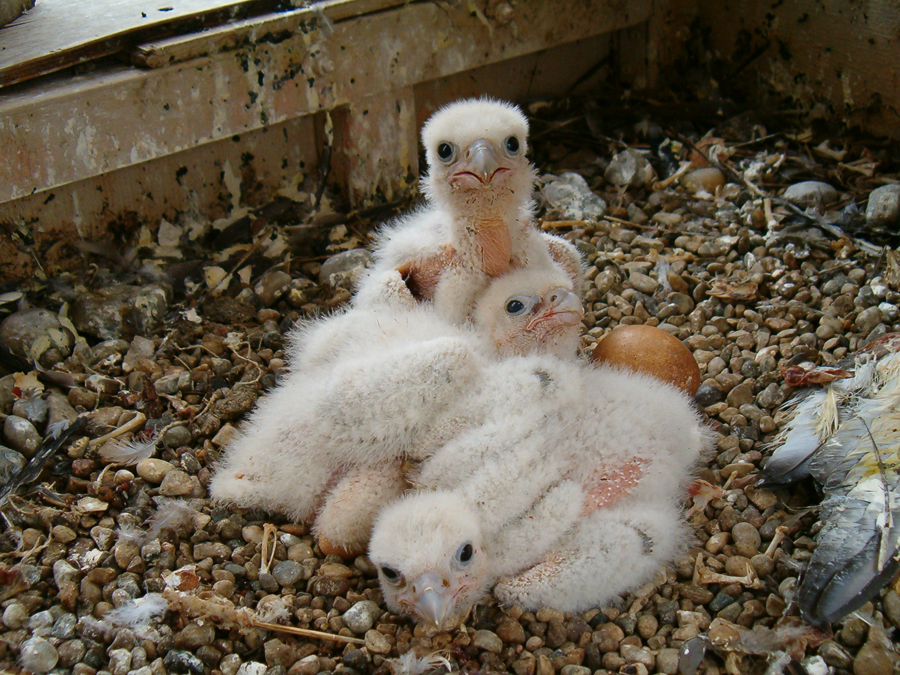Frequently Asked Questions

Photograph by Daniel Miller
What does a peregrine falcon look like? The adult peregrine is a crow-sized bird with a 36 to 44 inch wingspan. It has a dark
head with a wide dark mustache mark, white throat, blue-gray back and pale breast
cross-barred with dark brown. Young birds have darker, brownish plumage. Their breast
is marked with vertical brown streaking. The females are larger than the males.
How long do peregrine falcons live?
Peregrines may live to be 12 to 15 years old. However, the mortality rate for young
falcons is about 60%. This means that approximately 6 out of every 10 falcons hatched
will die in its first year of life.
Why do peregrine falcons nest on buildings?
Peregrines typically nest on ledges of rock cliffs. However, falcons have been able
to adapt to use tall buildings. If you think about it, a city skyscraper is tall and
constructed of concrete or stone, just like a rock cliff. Window boxes and other niches
on buildings provide a place for a female to lay eggs. Belle and Allen nest in a man-made
nest box provided by the Ohio Department of Natural Resources.
What kind of nest do peregrine falcons make?
Peregrine falcons do not bring nesting material to an area to build a nest. Instead,
they make what is called a scrape or shallow depression in existing gravel or other
debris by lying down and pushing back with a foot.
Why doesn’t Belle sit on her eggs all of the time?
Falcons typically begin incubation after the second or third egg. Before incubation
begins, the falcons may be observed standing in or near the nest guarding the eggs.
Once incubation begins, one of the adult falcons is usually sitting on the nest. However,
during warm weather or food exchanges between the male and female, the eggs may be
left unattended for short periods.
Will all of the eggs hatch?
Sometimes there is “egg failure,” which can result from a number of factors including
infertility, breakage or weather. The female may push an egg that has failed to the
side of the nest box. If an entire clutch is lost, the female may attempt to re-nest
several weeks later.
Is it normal for the chicks to be left unattended for extended periods of time?
Yes. For the first few weeks after hatching, the chicks are brooded almost constantly.
After approximately 2-3 weeks they no longer need constant brooding and the adults
often are outside the nest for extended periods.
How many young do peregrines have?
The female peregrine usually lays 3 or 4 eggs. The eggs are slightly smaller than
a chicken egg, and are mottled with a dark, reddish-brown pigment. The female does
most of the incubating, which takes about 33 days. While the female flies off to feed,
the male incubates the eggs. The newly hatched “eyases” weigh about 2 ounces and are
covered with fluffy white down feathers.
How long do young peregrines stay in the nest?
Approximately 6 weeks. The downy white feathers the nestlings have when they hatch
are gradually replaced by juvenile feathers in about three to five weeks. At about
6 weeks of age, young falcons will make their first attempts at flying. After they
fledge (take their first flight) they are referred to as fledglings and will be dependent
on the adult falcons until they can hunt for themselves (about 4 weeks later).
What do peregrine falcons eat/How do they get their food?
Peregrines eat birds and other things that fly. A peregrine will typically fly above
its prey, then fold its wings and dive or stoop at the other bird and strike it with
a half-closed foot. The falcon then retrieves the stunned or dead bird in midair.
Peregrines are also swift fliers that can simply fly up behind their prey and grab
it in mid-flight.
How much does a peregrine falcon eat in a day?
An adult peregrine will eat about 70 grams (2 1/2 ounces) of food per day. This
is equal to about two blackbirds.
Do peregrine falcons migrate?
Yes and no. Some falcons do migrate and some do not. Peregrines in the more northern
climates (Alaska and Greenland) are more likely to migrate during the winter to places
that have a milder climate, such as the southern United States, Central and South
America. Typically, Belle and Allen do not appear to migrate, probably because their
food source or prey base remains adequate.
Do peregrine falcons have any predators?
In remote areas, great horned owls, martins and some snakes prey on young falcons
still in the nest. However, in urban areas, peregrines have few predators.
What happens to the chicks once they leave the nest?
Shortly after fledging, the young falcons remain close to the nest and are frequently
observed perching on nearby buildings. The youngsters beg for food from the adults,
often loudly vocalizing. In addition, the chicks must develop and perfect their flying
skills. For the first few weeks, when perching on a ledge, the young birds are often
described as “dragging their wings,” “almost toppling over,” or “tilting.” Although
they may appear in distress, these are all normal behaviors. Once they leave the Toledo
area (August-September), biologists are unsure where the young falcons go.
Do peregrine falcons mate for life?
Peregrines generally do keep the same mate from year to year. However, if a member
of the pair dies, the surviving falcon will accept a replacement mate sometimes as
soon as a week after its mate died.


